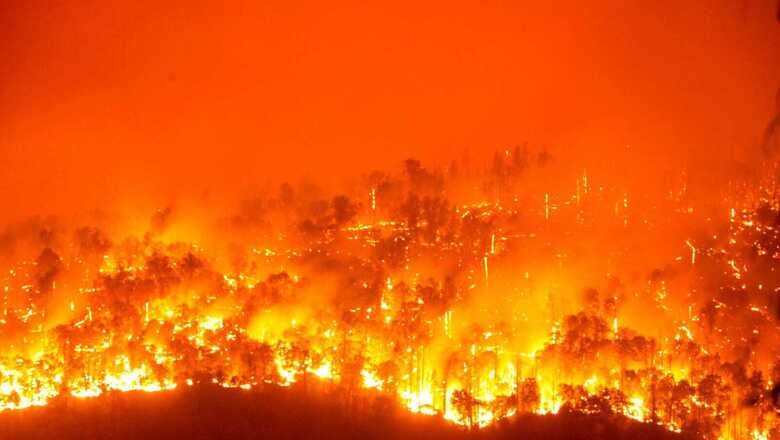
views
Similar incidents were reported from Odisha, Gujarat, Kerala, Assam, Tamil Nadu, and Uttarakhand. Vast tracts of land were consumed in Similipal Tiger Reserve, which is home to many endangered species, and Gujarat’s Mitiyala sanctuary, a protected area of Asiatic lions. These are just a few of the thousands of incidents that occur across states every summer and often escape our attention.
The large wild animals frantically flee to safer spots but still have to cope with wildfire smoke. The burnt forests take years to grow, slowing down natural regeneration and affecting biodiversity. The soil microbes are either wiped out or undergo unpredictable changes. Not to forget, the billion tonnes of carbon emissions that these fires add to the ecosystem every year.
It also amounts to a significant dent on the economy with at least one out of every four people in India dependent on forests for their livelihood. According to a 2018 report jointly prepared by the ministry of environment, forest and climate change (MoEFCC) and the World Bank, India loses at least Rs 1,100 crore due to forest fires every year.
Rethink approach to forest fires
We all know that over 85-90% of such incidents are man-made, either arising out of human carelessness, or deliberate actions leaving only 10-15% to the vagaries of the weather. There are cases where poachers have been known to set fire to hunt wild animals, or villagers start fires to collect non-timber forest products. Tropical countries like India are also vulnerable because of the hot and dry weather and where friction between two branches especially in the deciduous forests is also known to spark a fire.
As R Siddappa Setty, a scientist from Bengaluru-based Ashoka Trust for Research in Ecology and the Environment (ATREE), says, the major problem lies in our strategy around litter fires — somewhere between our transition from traditional ways of controlled fires, to putting a blanket ban on them.
Preventing major forest fires requires removing the fuel and the catalyst that trigger it. This explains why the seasonal clearance of leaf litter through controlled burning is critical. But over the years, the practice has come under criticism from biodiversity experts, due to its impact on flora and fauna and the growth of new species. “It was believed that this would do a good job in saving biodiversity. So, we started controlling forest fires everywhere. Unfortunately, this led to the accumulation of a lot of biomass in the forest, and caused big canopy fires that are more challenging to douse.”
But not all fires are harmful. We must understand that they serve an important ecological purpose. It is necessary to understand the difference between ‘good’ and ‘bad’ fires. If controlled burning is a solution to prevent future hazards, then what is the most effective way to implement it? Which areas are safer and which are not? What could be its consequences on biodiversity? All this requires intensive research and experiments, and a well-laid-out strategy. Different ways of clearing the litter through physical or chemical treatments can also be explored. At the same time, there must be efforts to eradicate invasive plant species that encroach the land at a menacing pace and often trigger villagers to start a fire. The growth of thick shrub (lantana camara) is particularly worrisome, impeding several forest conservation measures.
Invest in planning and quick action
Putting fire lines during winter has yielded significant results, and must be executed across all major forests that are vulnerable to fires. These are basically areas, which are cleared of vegetation to stop/slow the fire from spreading to the entire forest.
The use of GIS remote-sensing techniques has helped tremendously in detecting and tracking forest fires and ensuring quick action. But its role needs to expand further, in mapping specific areas which are more prone to fires and prioritising action. “Now we are getting an alert from the Forest Survey of India (FSI) within half an hour of fire detection, with details of the precise location. This has really helped in containing a fire before it escalates, and ensuring timely action. It is all about how early we get the alert, and mobilise forces,” said AK Srivastava, district forest officer in Alwar, Rajasthan.
Conservation of burnt land
The work does not stop at putting out a fire.
It is also important that the smouldering swathes of land left behind are rejuvenated or else they will become prone to soil erosion, and add to the problem of land degradation. The challenge is huge, and more institutions and organisations must come together to address it, and it must be done with the complete participation of local people.
With the world warming at an unprecedented rate, it is becoming difficult to control wildfires. They are burning longer and hotter and even flaring up in unexpected places. It is but certain that we are not currently prepared to face its gigantic consequences. We certainly cannot eliminate them but need to do a lot more towards their management and mitigation.
Read all the Latest News India and Breaking News here


















Comments
0 comment